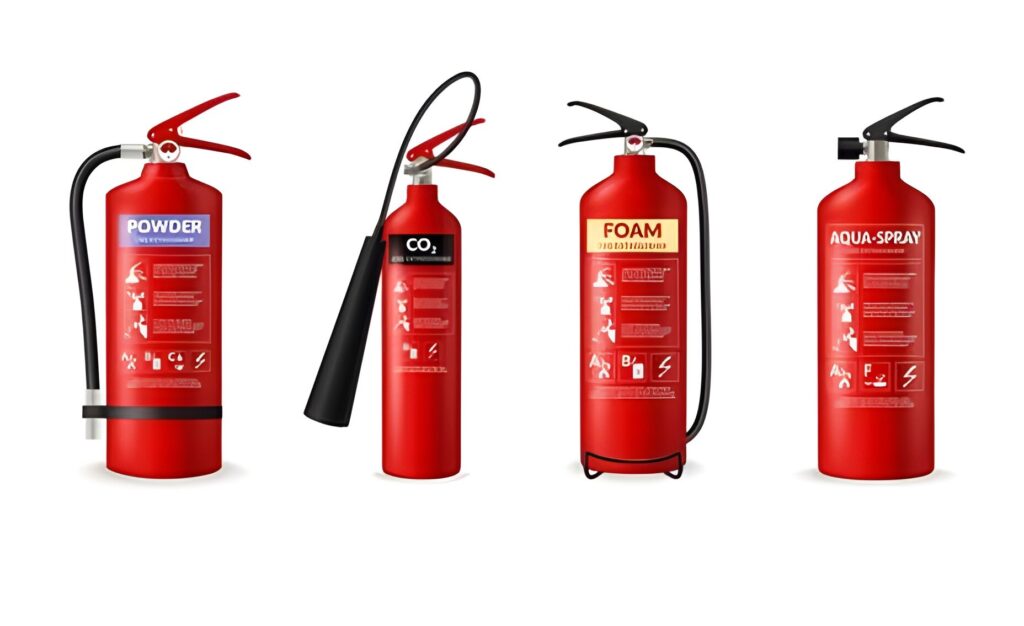A fire extinguisher is a crucial active firefighting device designed to extinguish or manage small fires in emergency situations. It is not suitable for tackling out-of-control fires that require the expertise of a fire brigade. Typically, a fire extinguisher comprises a handheld cylindrical pressure vessel containing an extinguishing agent that can be discharged to suppress a fire. Fire extinguishers play a pivotal role in controlling fires right from their inception. Therefore, timely servicing of your fire extinguishers by an approved civil defense contractor, in accordance with NFPA standards, is essential
Type of Fires
According to NFPA 10, fires can be classified into various classes, each requiring specific types of fire extinguishers and agents. Your fire protection specialist will determine the appropriate size and type of fire extinguisher tailored to the specific fire hazard.
Class A
Class A fires are fires in ordinary combustibles such as wood, paper, cloth, rubber, and many plastics.
Class B
Class B fires are fires in flammable liquids such as gasoline, petroleum greases, tars, oils, oil-based paints, solvents, alcohols. Class B fires also include flammable gases such as propane and butane. Class B fires do not include fires involving cooking oils and grease.
Class C
Class C fires are fires involving energized electical equipment such as computers, servers, motors, transformers, and appliances. Remove the power and the Class C fire becomes one of the other classes of fire.
Class D
Class D fires are fires in combustible metals such as magnesium, titanium, zirconium, sodium, lithium, and potassium.
Class K
Class K fires are fires in cooking oils and greases such as animal and vegetable fats. Some types of fire extinguishing agents can be used on more than one class of fire. Others have warnings where it would be dangerous for the operator to use on a particular fire extinguishing agent.
Types of Fire Extinguishers
Dry Chemical
Dry Chemical fire extinguishers disrupt the fire triangle’s chemical reaction. Multipurpose dry chemicals are effective against Class A, B, and C fires, while ordinary dry chemicals are suitable for Class B & C fires only.
Carbon Dioxide
Carbon Dioxide extinguishers work by removing the oxygen element and cooling the fire with a cold discharge. They are effective on Class B & C fires but generally ineffective on Class A fires.
Water and Foam
Water and Foam extinguishers remove the heat element from the fire triangle. Foam agents also separate the oxygen element. Water extinguishers are designed for Class A fires only and should not be used on Class B or C fires due to potential hazards.
Wet Chemical
Wet Chemical extinguishers remove heat and prevent re-ignition by creating a barrier between oxygen and fuel elements. They are designed for Class K fires in commercial kitchens and some are also effective on Class A fires.
Clean Agent
Clean Agent extinguishers interrupt the chemical reaction or remove heat from the fire triangle. They are effective against Class A, B, and C fires and are less harmful to the ozone layer.
Dry Powder
Dry Powder extinguishers separate the fuel from the oxygen element or remove the heat element. They are specifically for Class D fires involving combustible metals.
Fire Extinguisher Maintenance
Inspection
Fire extinguishers must undergo regular visual checks for gauge, date, cylinder condition, weight, hose, and seal integrity.
Testing
Pressure testing and inspection for damage should be conducted periodically, with refilling required as necessary. Hydrostatic testing is recommended every 5 years.
Service
Maintenance and servicing should only be performed by certified experts to ensure proper operation during emergencies.
Daily Check
Daily quick checks ensure extinguishers are in the correct location, visible, accessible, and indicate correct pressure levels as per Abu Dhabi Civil Defense requirements.
